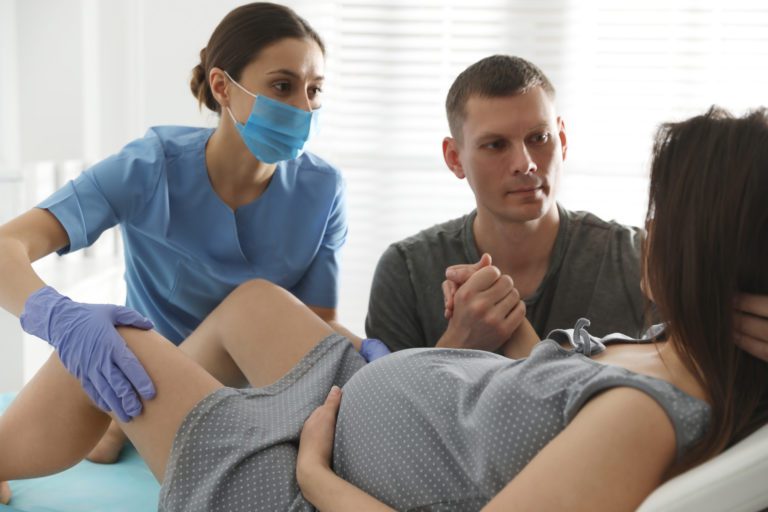With the COVID-19 pandemic, more moms are choosing to give birth at home or in free-standing birth centers. And for good reason! Fear of exposure to the Coronavirus and the desire to have the support people of their choosing around them are two leading reasons for this trend.
But as with every choice in pregnancy and birth, it’s important to consider the risks, benefits, and alternatives, and review the evidence to be sure you’re making an informed decision. If you’re considering an out-of-hospital birth, read on as we take a deep dive into birthing options.
Birth with a Midwife
Most out-of-hospital births are attended by midwives, though some physicians also attend births outside of hospitals. In the US, there are essentially three different types of midwives:
- Certified Nurse-Midwives (CNMs) — are advanced practice registered nurses with at least a master’s degree, who must pass a national certification examination. They practice in every state, can prescribe medications, and can provide care in all birth settings (in fact, most CNMs work in hospitals).
- Certified Midwives (CMs) — also have graduate level education and must pass the same exams as CNMs but are not nurses. So far, only a few states recognize CMs as primary care providers and allow CMs to practice.
- Certified Professional Midwives (CPMs) — are experts in out-of- hospital birth. They don’t have prescriptive authority and aren’t recognized as primary care providers in all states; their training varies by state and by program.
Midwives typically provide good outcomes because of their increased emphasis on good prenatal care, and their personal attention throughout labor and birth. Be sure to establish care with your midwife early in the pregnancy and keep all your appointments to fully take advantage of the benefits of midwifery care!
Birthplace: Home or Freestanding Birth Center
When we talk about an out-of-hospital birth, we’re usually referring either to giving birth at home or in a freestanding birth center. The laws that govern where midwives can legally attend births vary from state to state. and you can find out which options are available in your state here https://mana.org/about-midwives/ state-by-state
Risks vs. Benefits
Research shows midwifery care is associated with greater chances of a healthy vaginal birth, better rates of starting and sustaining breastfeeding, and higher patient satisfaction scores regardless of where the birth occurs.
Since most out-of-hospital births are attended by midwives, it’s no surprise that home birth and birth center birth outcomes have far lower cesarean birth rates than hospitals.
Still, it’s important to consider safety. Research shows that the rate of neonatal deaths is higher with home birth than with freestanding birth centers or hospitals (3.9 vs. 1.8 deaths per 1000 births). So, where is the tradeoff?
How to Choose a Birthplace
Researchers in the Centers for Medicare and Medicaid Strong Start for Mothers and Newborns Initiative study discovered that in addition to an excellent safety profile, freestanding birth centers had the best outcomes overall for birth when compared with hospitals.
In general, freestanding birth centers and home births result in lower cesarean surgery rates, fewer preterm births, higher rates of satisfaction, lower costs, and no increase in risk for moms or babies. The doctors of the American College of Obstetricians and Gynecologists agree and recommend hospitals and accredited birth centers as the safest place to birth.
However, the American College of Nurse Midwives suggest that “Home birth is best accomplished in
an integrated, supportive system of safe, seamless care with respectful collaboration among all health care providers and institutions if a transfer of care from home to hospital becomes necessary.” This speaks to the fact that sometimes plans change and the birthing family may need to be transferred to the hospital.
Transferring from Home to Hospital
Research shows that approximately 12% of all planned out-of-hospital births will likely require transfer to the hospital for mom and baby, either during labor or shortly after. About 75% of these transfers happen for non-urgent reasons, such as pain management and labor augmentation (pitocin to help move labor along).
About 25% of these transfers are for an urgent reason, such as heavy bleeding or fetal distress. It’s also worth mentioning that transfers are far more likely to happen with first-time mothers.
Considering Cost
Another important thing to consider when choosing where to give birth is
the cost. While home birth and birth center birth do cost much less than hospital birth, insurance coverage varies significantly across the country. Not all private insurance companies’ contract with community-based midwives, and some providers do not accept Medicaid.
Is Your Pregnancy Low-Risk?
Birth center or home-based births are best when your pregnancy is low risk. Your pregnancy can be considered low risk if you have:
- A single baby
- Baby is head down
- Labor begins between 37 and 42 weeks of pregnancy
- No serious medical conditions (heart disease, kidney disease, blood clotting disorders, type I diabetes, gestational diabetes managed with insulin, preeclampsia, or bleeding)
- Placenta is safely away from the cervix when labor begins
- No active genital herpes when labor begins
Some midwives can offer vaginal birth after cesarean (VBAC) in an out-of- hospital setting, but policies and laws vary from state to state. If you’ve had a cesarean section previously, you’ll want to discuss your options with your midwife.
Take Time to Prepare for a Birth Center or Home Birth
Part of planning for a home-based or birth center birth means taking the time to prepare! Families who plan to birth outside the hospital should take childbirth classes and expect to labor without an epidural.
Some midwives offer nitrous oxide, but most families use natural techniques to cope with labor, such as laboring in water or walking while laboring. Eat well, exercise daily, take your prenatal vitamins to start labor in the best health possible.
YOU MAY ALSO LIKE: Choosing an Unmedicated Natural Birth






Comments are closed.